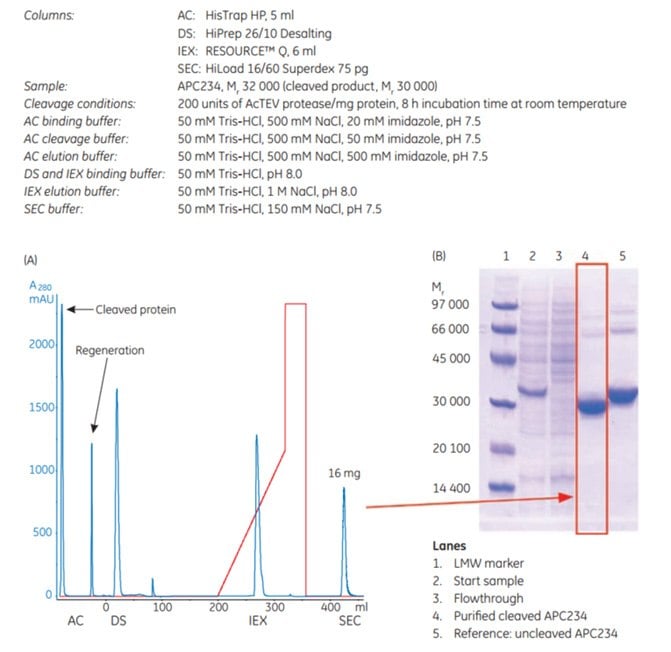Tag Removal by Enzymatic Cleavage
In most cases, functional tests can be performed using the intact histidine-tagged protein. If removal of the tag is necessary, then procedures similar to GST tag removal can be followed, that is, specific recognition sites are incorporated to allow subsequent enzymatic cleavage. The precise protocols required for cleavage and purification will depend on the original vectors and the properties of the specific enzymes used for cleavage.
rTEV protease (Invitrogen) has a (histidine)6-tag and recognizes the amino acid sequence Glu-Asn-Leu-Tyr-Phe-Gln↓Gly. Glu, Tyr, Gln and Gly are needed for cleavage between the Gln and Gly residues (↓). N-terminal (histidine)6-tags can be removed. The advantage of this enzymatic cleavage is that the protein of interest can be repurified using the same Ni Sepharose medium or prepacked column. The (histidine)6-tag and the (histidine)6-tag rTEV protease will both bind to the column, and the protein of interest can be collected in the flowthrough.
The amount of enzyme, temperature, and length of incubation required for complete digestion vary according to the specific tagged protein produced. Determine optimal conditions in preliminary experiments. Remove samples at various time points and analyze by SDS-PAGE to estimate the yield, purity, and extent of digestion. Approximate molecular weights for SDS-PAGE analysis:
| r TEV protease C arboxypeptidase A* |
Mr 29 000 Mr 94 000 |
* for the removal of C-terminal (histidine)6-tags.
Some cleavage procedures will require a second purification step to remove the protease or other contaminants. Conventional chromatographic separation techniques such as SEC (usually no need for optimization), IEX, or HIC will need to be developed (Appendix 11, Principles and standard conditions for different purification techniques).
Application example
Automatic histidine tag removal using ÄKTAxpress
On the following page we present an example of automated tag removal using ÄKTAxpress. All multistep purification protocols in ÄKTAxpress can be combined with automated on-column tag cleavage. Tag cleavage is always performed on the affinity column prior to further purification steps. When the cleaved protein has been eluted, the affinity column is regenerated and affinity tag, tagged protease, and remaining uncleaved protein are collected in a separate outlet. The procedure involves binding the tagged protein, injection of protease, incubation, elution of cleaved protein, and collection in capillary loop(s), followed by further purification steps.
Four-step protocol: (histidine)6-tagged protein cleaved with AcTEV™ protease
The example in Figure 3.53 shows purification results for a (histidine)6-tagged protein, APC234 (Mr 32 500), expressed in E. coli. The Mr of the cleaved product is 30 000. After harvest, cell lysis was performed by sonication. The samples were clarified by centrifugation prior to sample loading.
AC, DS, IEX, and SEC were all performed on ÄKTAxpress using columns as indicated in the figure. The purity of each sample was analyzed by SDS-PAGE (Coomassie staining). The reduced samples were applied on an SDS-polyacrylamide gel. Approximately 7.5 µg of protein was loaded per lane.1

Figure 3.53.(A) Four-step protocol for purification of (histidine)6-tagged protein cleaved with AcTEV protease. (B) SDS-PAGE analysis. The gel was stained with Coomassie.
Materials
References
如要继续阅读,请登录或创建帐户。
暂无帐户?